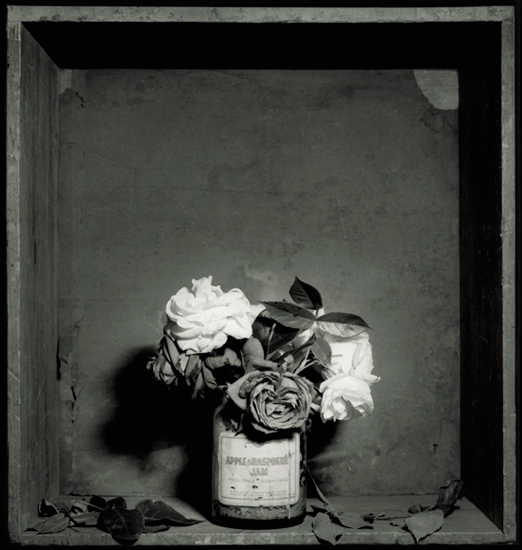Photo Insight with Andrew Sanderson

A renowned photographer, tutor, author and Ilford Master Printer, Andrew Sanderson offers practical tips on working with film and traditional darkroom techniques
I take a lot of photographs of still-life subjects, and many of my images are of objects that I’ve found because I’ve liked their particular character or shape. More often than not I’ve been attracted by an arrangement of shapes or light and shadow. However, this image is a little different because it is obviously set-up.
I used to live above an old antiques shop. In the cellar there was a workshop and within that I discovered an old jam jar that had been used to store paint. If you look at the image carefully, you can see some dried paint that has dribbled down the side. There was something about this jar that I really fell in love with and I knew I had to photograph it. I took it to the studio and, as is often the case, it sat around for years before I actually got round to doing anything with it.
At some point I began producing a series of images that involved me making a frame out of an old drawer with dark blue lining paper in the bottom. You can see that, behind the flowers, the paper is torn a little in the corners. I fastened the drawer to the wall and in some versions (and I probably shouldn’t say this) you can just spot a not-so-expertly retouched area in the top centre of the picture where I’ve removed the screw that is holding it to the wall.
Once I had the drawer on the wall, I realised that I could use it as a miniature controlled environment to present a range of photographic subjects. I thought of it as a kind of discipline where I could produce a series of images within this limited space. When you put restrictions on yourself like this, you force yourself to think. It takes you off into areas that you may not have otherwise discovered.
I had one large tungsten light and I attempted a range of images with different objects. The picture you see here is actually the first one I did. I took one shot and that was enough. It’s a popular image and one that people often point to.
Flowers are always lovely to photograph. There’s something about the tonality in them that’s really fantastic and endlessly rewarding. In this image, the dark tones in the wood and the lining paper in the back are not mid-grey and they’re not black – it’s that lovely tone in between – while the flowers themselves are between midtone and white. Those are the most interesting parts of the tonal scale for me. I like having just a bit more tone than white and just a bit more detail than dark shadow. This picture holds both of those in abundance. If you’re able to bring out these tones in a print, it has an almost sensual quality that is difficult to define. People will be drawn to look at it, but they won’t necessarily know why.

The beauty of having a studio is that you can set up a still-life shot, walk away from it and go back a few weeks later. You can think about what you’ve done and even reshoot it if you’re not happy. When you’re in the great outdoors, the landscape is always changing. For example, the light is always different or the leaves are falling from the trees, so you have to react to the situation as you find it. Using a studio means you’re in control and nothing is going to change. Having said that, I find that I am spending less and less time in the studio, what with work and family commitments. However, that’s not a bad thing, because it means that when I do get to put something together, it makes me focus my mind so I do the best job I can with limited time.
I hope this image shows that there’s no need to stop producing imagery just because it’s winter. Photography doesn’t stop when the temperature drops. You can easily set up your own studio in your living room. I’ve produced a great number of images indoors, whether it’s a piece of pottery or just some cutlery.
Images can be shot using window light and something as simple as MDF or card as a background. You can even just use your kitchen table. It really is one of the simplest and easiest things to do. You have lights all over your home and at times I’ve even lit a subject using torches and candlelight.
I rarely use flash because I like to see where the shadows are falling. American photographer Diane Arbus famously said that she hated using flash (although it’s often present within her work) because at the moment of exposure you are essentially blind. The mirror goes up, the flash goes off, but you don’t actually see the subject and you don’t see where the shadows are – and shadows can make or break an image. So if you’re taking still-life photographs, tungsten lights are preferable. You can use something as simple as an Anglepoise lamp.
I find that people are always interested in roses and things that are ‘vintage’, to use the buzzword. I’m surprised that people like the same subjects as I do because I always assume that it’s only me who likes such old tatty things. I have a studio full of this kind of stuff, which is overflowing, and if anyone saw it they’d be horrified.
Andrew Sanderson was talking to Oliver Atwell

If you would like to read more about paper negatives, Andrew’s book Paper Negative Photography is available from www.blurb.com, price £15




